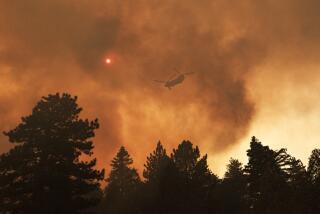So that’s why Beijing’s skies were polluted during a national holiday
Beijingers, well-accustomed to eye-watering air pollution, have long found some respite in official holidays, when the city’s traffic eases and its factories temporarily close, granting them a few precious days of fresh air.
But not this year. During several days of the National Day holiday, Oct. 1-7, Beijing’s skies were ashen, leaving many “staycationing” residents scratching their heads about what could be making the air so thick.
On Thursday, the Chinese government provided an answer: Hundreds of farmers, primarily in impoverished Henan province, were burning crop debris to cap a corn harvest, creating smoke clouds that blew hundreds of miles north to the capital.
On Oct. 5, 6 and 7, Beijing’s levels of PM 2.5 — particulate matter small enough to lodge deep in the lungs — averaged at around 250 micrograms per cubic meter, according to Chinese government readings. That’s about 10 times the level recommended by the World Health Organization.
China’s Ministry of Environmental Protection said in a statement Wednesday that according to satellite surveillance data, farmers sparked 376 corn stalk conflagrations during the holiday— an increase of 53 fires over 2014. (China’s official New China News Agency reported the announcement Thursday.)
The practice of burning crop debris, called “stubble burning,” is an inexpensive, low-effort way for farmers to clear their fields, killing pests and weeds in the process. The practice is common, though generally well-regulated, in several Western countries, including the United States.
The intensity of pollution from stubble burning in China underscores the complexity of the country’s smog problem and the wide range of approaches that will be required to stamp it out.
Although the Chinese government banned stubble burning in 1999, it set the maximum fine for offending farmers at about $3, and so the practice remains widespread. (Local officials who are caught condoning the practice, however, can have about $80,000 taken from their coffers.)
According to state media, northern China is particularly vulnerable to stubble-burning-related pollution twice a year: just after a corn harvest in September and October, and a wheat harvest in May and June. This spring, authorities in Henan identified 468 stubble fires across the province, and levied $37 million in corresponding fines.
This week, authorities found stubble fires across nine provinces and regions including Henan, Shandong, Liaoning, Xinjiang, Anhui, Hubei, Hebei, Helongjiang and Inner Mongolia.
Beijing’s pollution is not the only hazard of rampant stubble burning. According to an article in Dahe News, a newspaper in Henan province, one villager suffered burns over 95% of his body after trying to walk through a field where farmers were burning their corn stalks.
On Sept. 28, a hospital respiratory ward in Henan’s provincial capital, Zhengzhou, admitted 180 children who were sickened by smoke generated by nearby stalk-burning farmers, according to the newspaper.
China’s official New China News Agency said in an editorial Thursday that officials should provide “better solutions” for farmers to dispose of their corn stalks.
“In the eyes of the farmers, burning stalks is not only a tradition, but also the most economic way of handling the stalks,” it said. “All other recycling methods waste time, energy and money, and could also delay their farming. … In addition to preventing farmers from burning stalks, the authorities should focus more on how to help them find better solutions.”
Tommy Yang in The Times’ Beijing bureau contributed to this report
ALSO
Svetlana Alexievich, winner of Nobel Prize in Literature, ‘devised a new kind of literary genre’
Analysis: In Putin’s military escalation in Syria, one clear loser: Obama
Under the Fair Pay Act, will Jennifer Lawrence get paid like Bradley Cooper?
More to Read
Sign up for Essential California
The most important California stories and recommendations in your inbox every morning.
You may occasionally receive promotional content from the Los Angeles Times.










